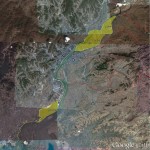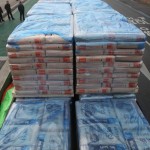According to Business Week:
North Korea’s trade expanded more than 20 percent in 2010 to $6.1 billion on growing business with China even as the economy shrank for a second year, South Korea’s national statistics office said.
Trade volume increased 22.3 percent in 2010 after a 10.5 percent decline in 2009, Statistics Korea said in its annual report today in Seoul. Commerce with China accounted for 57 percent, or $3.5 billion, of North Korea’s foreign trade, up from 53 percent in the previous year. The totalitarian state doesn’t report economic statistics.
North Korea’s gross domestic product contracted 0.5 percent to 30 trillion won ($26.1 billion) in 2010, compared with South Korea’s 1,173 trillion won, the Bank of Korea said in November. Per capita income was 1.24 million won compared with South Korea’s 24 million won.
Kim Jong Un took over as leader of North Korea in December after the death of his father, Kim Jong Il. The regime has relied on economic handouts since the mid-1990s and an estimated 2 million people have died from famine, according to South Korea’s central bank. The United Nations and the U.S. increased sanctions on the country aimed at curtailing its nuclear weapons program after 2010 attacks that killed 50 South Koreans.
Chinese aid to the stricken country will probably increase as the government in Beijing seeks to avoid a flood of refugees from crossing the 880-mile (1,416 kilometer) border it shares with North Korea, analyst Dong Yong Sueng said. While food shortages have contributed to rising defections, North Korea has shown no willingness to ease sanctions by abandoning its nuclear weapons program.
Economic Dependence
“North Korea’s economic dependence on China will inevitably increase for the time being unless there’s some resolution to the nuclear situation,” said Dong, a senior fellow at the Samsung Economic Research Institute in Seoul. “China wants a stable North Korean regime and succession to avoid a potential influx of refugees.”
North Korea had a shortfall of as much as 700,000 metric tons of food last year, which could affect a quarter of the population, according to the United Nations Food & Agriculture Organization. China provides almost 90 percent of energy imports and 45 percent of the country’s food, according to a 2009 report from the New York-based Council on Foreign Relations.
China is preparing to consent to a North Korean request to provide 1 million tons of food in time for the April 5 anniversary of the birth of the country’s founder, Kim Il Sung, Japan’s Fuji Television said on its website. The report didn’t say where it obtained the information.
Providing Assistance
Chinese Foreign Ministry spokesman Liu Weimin today told reporters in Beijing that while he wasn’t aware of the report, “we have always been providing assistance to the DPRK within our capacity which we think will be conducive to the stability and development of the country.” DPRK is an acronym of North Korea’s formal name, the Democratic People’s Republic of Korea.
Kim’s military had over one million soldiers in active duty and 7.7 million reserve troops as of November 2010, today’s report said, citing South Korean Defense Ministry figures. The North operates under a military-first policy and has remained on combat alert since the Korean War ended in 1953 with a truce and not a peace treaty.
North Korea’s population rose to 24.2 million in 2010 from 24.1 million in 2009, about half of South Korea. Inter-Korean trade rose 13.9 percent from a year earlier to $1.9 billion last year, Statistics Korea said.
South Korea plans to set up a fund to raise as much as 55 trillion won to pay for eventual reunification with North Korea, Unification Minister Yu Woo Ik said in an interview with Bloomberg last October.
Read Sangwon Yoon’s full article in Business Week here.
The data in this article was pulled from a recent publication by Statistics Korea (Korean, English). You can read a press release of the publication here (in Korean). You can read the press release in English here (via Google Translate). It is not very good, so if a reader would care to take the time to translate this article, I would appreciate it. You can also download the press release as a .hwp file at the bottom of the article (download a .hwp reader here).
Statistics Korea did set up a North Korea Statistics page which you can see here. Unfortunately, it is only in Korean! I have, however, added it as a link on my North Korean Economic Statistics page.
UPDATE 1: The Daily NK also covered this story with the following report:
The income gap between North and South Korea is becoming ever wider, according to statistics released yesterday by Statistics Korea showing that South Korea’s per capita Gross National Income (GNI) in 2010 was $27,592, 19.3 times that of North Korea at $1,074. Last year the gap was 18.4 times.
In the (legal) foreign trade sector, the two Koreas also lived very differently. South Korea’s 2012 trading volume was $891.6 billion, 212.3 times North Korea’s $4.2 billion. North Korea’s exports were worth just $15 billion, its imports $27 billion.
As expected, North Korea’s trade reliance on China was highly significant (56.9%), partly because as strained inter-Korean relations started to bite, so inter-Korean trade declined as well: from 33.0% in 2009 to 31.4% in 2010.
Meanwhile, 61.0% of adults in South Korea are economically active, a number which rises to 70.2% in North Korea. Conversely, there are 3,134,000 college students in South Korea, but only 510,000 in North Korea.
In the energy industry sector in 2010, South Korea imported 872,415,000 barrels of crude oil, 226.4 times more than North Korea’s 3,854,000. The electricity generating capacity of South Korea is 10.9 times more than that of North Korea, too, though the generated amount was actually around 20 times bigger, the statistics allege.
Automobile production was no better; in South Korea (4,272,000), 1,068 times more than North Korea (4,000). Steel production in South Korea was 46.1 times that of North Korea, cement was 7.6 times more, and fertilizer 6.1 times.
UPDATE 2: The Hankyoreh adds some critiques of the data:
“With inter-Korean relations so tense, it is no longer possible for us to do the kind of North Korean grain production estimates that were possible under the previous administration,” a government official explained on Tuesday.
2010 production figures for rice, corn, barley, beans, and other major grains were left blank in a Statistics Korea report on major statistical indicators in North Korea. The numbers were included in statistical data released in 2008, 2009, and other years.
A Statistics Korea official said, “We made several requests to the organization in charge, but they didn’t provide materials, so we couldn’t print them.” The Rural Development Administration is responsible for investigating North Korean grain production. Early every year, it has estimated and released North Korean grain production figures for the previous year. Since 2011, however, it has failed to release figures.
A government official explained, “Since inter-Korean relations were decent during the previous administration, it was possible to go to the North and get samples to use as a basis for estimates.”
“With inter-Korean exchange all but completely halted under the current administration, the basis for releasing estimates has disappeared,” the official added.
Some observers said the decision was motivated by concerns that South Korean public support for food aid to North Korea could grow if low figures are presented. The argument is that there is no reason the kind of grain production estimates that were possible in 2008 and 2009, while the Lee administration was in office, would not be so for 2010 alone. Observers are also expressing bafflement at the fact that only agricultural products were omitted from estimates at a time when even the number of cars is being estimated in the area of industrial products.
Kim Yong-hyun, a professor of North Korean studies at Dongguk University, said, “Recently, food aid negotiations have been taking place between North Korea and the US, and I suspect the government may have decided not to announce [the estimates] because it was too concerned about public sentiment in South Korea.”
The North Korea figures released Tuesday also showed South Korea‘s per capita gross national income of $20,759 to be 19.3 times North Korea’s $174 for 2010.


